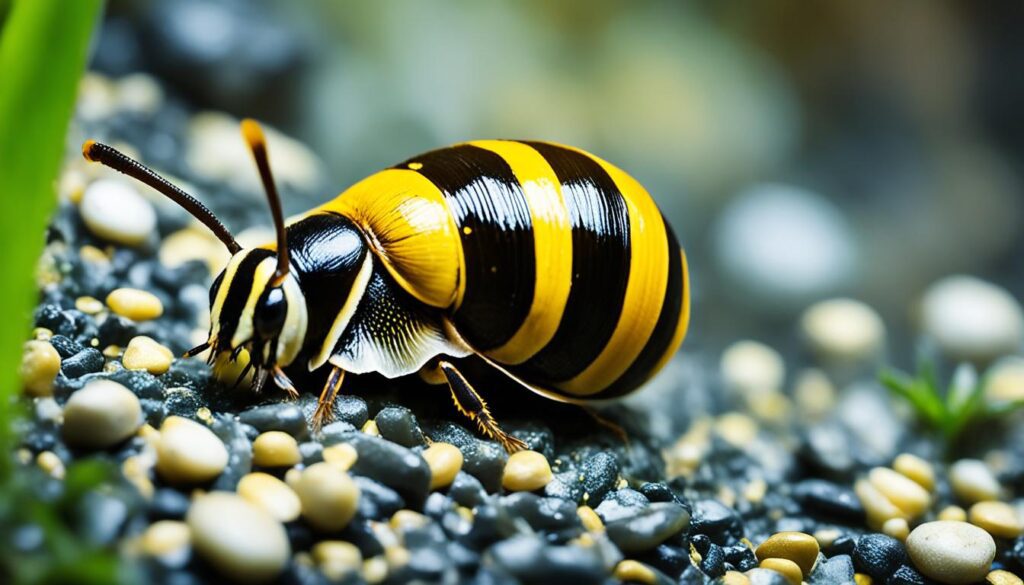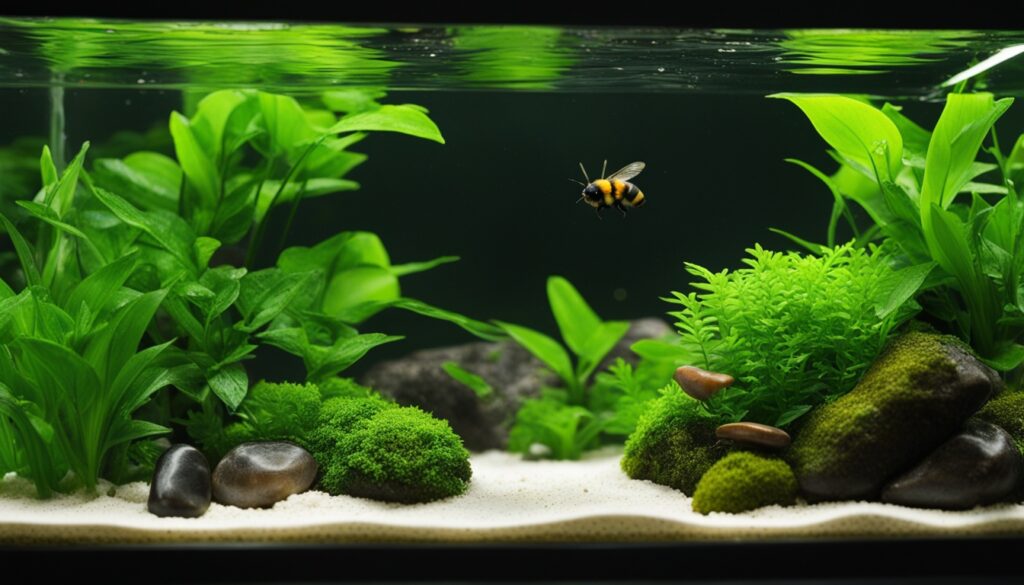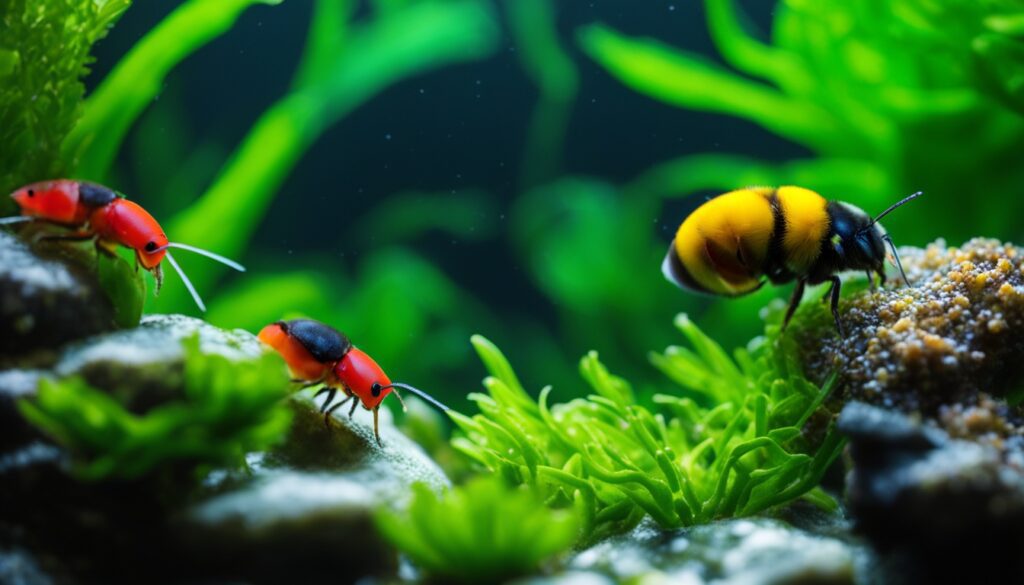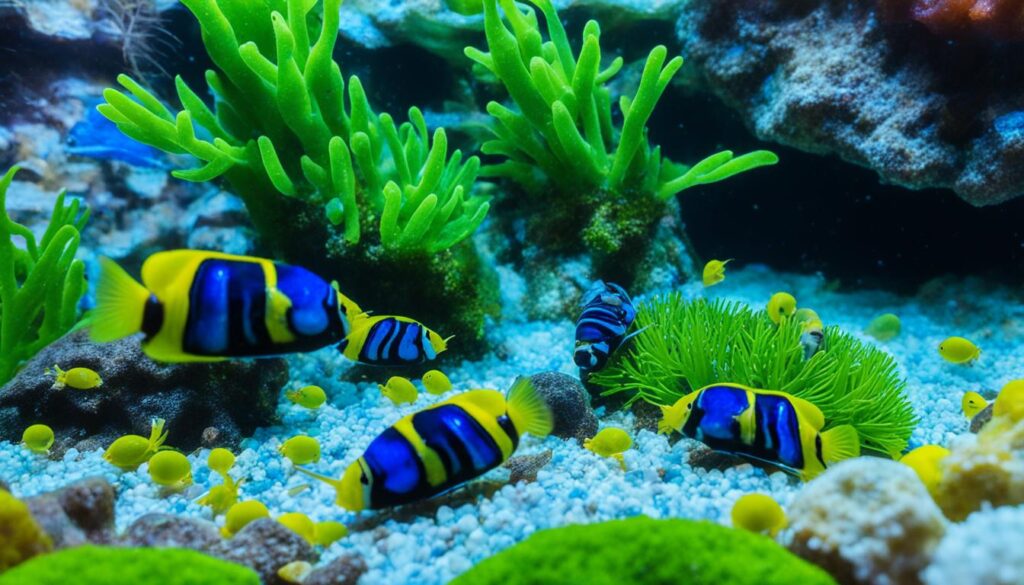Discover the amazing world of bumblebee snail care! These small creatures add fun and color to saltwater tanks. I’ll help you learn how to create the perfect home for them. Let’s explore how to keep these interesting snails happy and healthy.
Bumblebee Snails live up to two years and look cool with their yellow and black stripes. Despite their size, under 0.6 inches, they are vital for cleaning the tank. They adjust well to life in your aquarium.
Setting up for Bumblebee Snails is simple. They need at least a 5-gallon tank to feel at home. Ensure water conditions stay stable, with temperatures of 72 to 78°F. They also require a pH of 8.1 to 8.4, and a specific gravity of 1.023 to 1.025.
These snails are busy at night, making them great partners for day-active fish. As your other fish sleep, Bumblebee Snails clean up.
Unveiling the Bumblebee Snail: An Aquarist’s Tiny Gem

The Engina mendicaria, known as the Bumblebee Snail, shows us a captivating side of marine life. It boosts the look of aquariums. This little snail not only catches the eye but also helps balance the environment in its home.
Origins and Natural Habitat: From Indo-Pacific to Home Tanks
The Bumblebee Snail comes from the warm Indo-Pacific waters. It’s found from Indonesia’s coastlines to Africa’s reefs and Florida’s tropical seas. The snail is at home among coral rubble and sandy bases, easily adjusting to different settings.
Out in nature, the Engina mendicaria eats detritus and decaying stuff. This keeps their homes clean and healthy. In aquariums, they help by controlling algae and cleaning the substrate.
Recognizing the Striped Beauty: Appearance and Distinctive Features
The Bumblebee Snail’s shell stands out with bold, black stripes on a light background. Its shell not only adds to tank beauty but also keeps the snail safe. Even though they’re small, their patterned shells catch your eye.
When picking a Bumblebee Snail, go for ones from trusted sellers. This ensures they’re healthy and can adapt to their new tank. Adding these snails not only makes your tank prettier but also healthier.
These snails show resilience and adaptability from the vast Indo-Pacific to home tanks. They clean habitats and add to the tank’s beauty. Bumblebee Snails are truly treasures for enhancing both function and appearance of aquariums.
The Essential Aspects of Bumblebee Snail Care

Starting the care journey for bumblebee snails means knowing their needs. From tank setup to their diet and overall tank care, every step is key. These steps make sure these small intriguing creatures stay healthy and happy.
Creating the Perfect Environment: Tank Size and Setup
First, setting up the right home is key. A 10-gallon tank at least is suggested for them. This gives them space to explore and forage. The tank should have lots of hiding spots with live rocks and a deep substrate. This mirrors their natural home and helps them feel well.
Water Parameters: Ensuring the Ideal Conditions
Keeping an eye on water conditions is critical for bumblebee snail care. The water temp should be between 72-78°F. Keep the pH level at 8.1-8.4. Salinity needs to stay at 1.023 to 1.025 specific gravity. These conditions mimic their ocean home and keep them stress-free and healthy.
Dietary Preferences: Feeding Your Bumblebee Snail
Bumblebee snails need various foods, like they would find in nature. They eat detritus, leftover food, and algae. While they help control algae, they shouldn’t be the only solution for it. Adding meaty foods to their diet keeps them active and well.
Proper tank care isn’t just for looks; it’s about keeping a healthy ecosystem. This means doing regular maintenance, feeding on time, and checking water quality. These actions help your aquatic pets flourish.
Parameter |
Required Level |
|---|---|
Temperature |
72-78°F |
pH Level |
8.1-8.4 |
Salinity |
1.023-1.025 |
Lastly, following bumblebee snail care principles not only keeps them well but enhances your aquarist journey. Paying close attention to their needs rewards you by seeing them thrive in a well-kept tank.
Bumblebee Snail Behavior and Social Dynamics

The life of a bumblebee snail is interesting. It lives at night and gets along well in aquariums. These snails are active when it’s dark. This is what makes them special to those who have aquariums. Knowing about their night habits helps make a better home for them.
Understanding Nocturnal Habits: Activity and Rest Cycles
Bumblebee snails are active at night. They move around when it’s dark. This helps them stay less stressed and find food better. Making their tank like their natural home is good for them.
In the day, they hide under rocks or in the sand. They rest to get ready for the night. This resting and being active cycle is important. For more on how nocturnal creatures behave, look at this study.
Peaceful Coexistence: Interactions with Tank Mates
The bumblebee snail is good at staying out of trouble in the tank. It doesn’t bother other creatures. It helps keep the tank clean by eating waste.
They also get along with many other aquarium creatures. They’re great for tanks with different kinds of animals. They help make the tank a better place.
Bumblebee snails are important in the world of night creatures. They make aquariums more interesting. By looking after them well, aquarium owners can help them do well. This shows how delicate the balance is in an aquarium.
Aquarium Companions: Introducing Bumblebee Snail Tank Mates

Adding bumblebee snails to your aquarium brings a vibrant touch. The key to success lies in selecting the right tank mates. This ensures harmony and community tank diversity. From my experience, choosing safe companions is vital. It helps keep the balance and secures the well-being of all creatures living together.
Selecting Compatible Tank Mates: Shrimp, Snails, and Fish
Choosing the right friends for your snails means picking non-threatening species. Good choices include Sexy Shrimp, Red Fire Shrimp, and a few types of snails. These include Fighting Conch Snail, Astrea Snail, Mexican Turbo Snail, and Cerith Snail. These species coexist peacefully with bumblebee snails. They help maintain a balanced and secure environment. Making sure everyone gets along is crucial for a healthy tank ecosystem.
Potential Threats: Predator Awareness and Prevention
It’s also important to know the tank’s potential threats. Watch out for larger shrimp, some wrasses, and hermit crabs. They can be dangerous to your bumblebee snails. These predators could stress or even harm the snails, disrupting their eating. By choosing carefully and understanding each species’ behaviors, you can prevent these risks. This way, you ensure a safe tank mates environment.
Adding new members to your tank changes its dynamics. Regular check-ups and tweaks are needed. This helps keep the community tank diversity and makes sure your tank is peaceful. A place where every species, including bumblebee snails, can thrive.
Navigating Health and Wellness for Bumblebee Snails
Keeping your water pets healthy is very important, especially for bumblebee snails. Their health depends a lot on how well the aquarium filter works and if the water is stable. These snails help keep the tank clean by eating algae. But they need a living space that fits their special needs. Here, we’ll talk about common health issues and why good water quality is crucial.
Common Health Concerns: Identifying and Addressing Issues
Watching out for dangers is key to keeping bumblebee snails healthy. They can die from copper, which is sometimes in fish medicine. Also, too much nitrate is harmful. Malaysian Trumpet Snails grow fast. They aren’t bad, but too many can upset the tank’s balance. To avoid problems, keep new snails in quarantine. Use things like alum to clean plants from snails and eggs before adding them to your tank.
Maintaining Pristine Water Quality: Filtration and Regular Maintenance
Looking after your tank means cleaning it every week and checking the water. I suggest using a strong filter. This cleans the water and helps good germs grow. Some people use predators, like loaches or assassin snails, to handle pests. But, you have to be careful not to create new issues. Nerite snails are harmless and can live with bumblebee snails if the water is good. Learning about snail health and keeping your tank clean will help your bumblebee snails. This makes the whole aquarium healthier.








